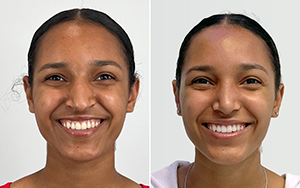Brow Lift Consultation
Brow Lift Consultation & Physical Exam
- Brow Lift Overview
- Are You a Good Candidate for Brow Lift?
- What Do You Want to Change?
- Brow Lift Procedures
- Benefits of Brow Lift
- Joseph T Cruise, MD's Brow Lift Philosophy
- Brow Lift Consultation and Physical Exam
- Prior to Brow Lift
- Brow Lift Anesthesia
- After Brow Lift
- Recovery from Brow Lift
- Possible Complications
- Brow Lift Cost and Financing
- Brow Lift Words to Know
- Brow Lift Before and After Pictures
We have outlined below what you can expect from your brow lift/temple lift consultation with Joseph T Cruise, MD. Read carefully, as there are many suggestions that will save you time, clear up questions, and help you convey to your plastic surgeon what you want to accomplish.
Health History
All cosmetic surgery consultations begin with a thorough health history. This is especially true if general anesthesia is being used, but also applies to local anesthesia. Prior to meeting with the plastic surgeon you will be given a health history questionnaire. There are five areas of your health you will be asked about. Be sure to answer it with detail so that your surgery and anesthesia can be optimized for you.
General Health
General health problems are important to discuss so that your surgery is as safe as possible. Be sure to mention any chronic illness. Of particular concern are high blood pressure, diabetes, heart problems, liver and kidney disease, stroke, cancer, bleeding problems, and wound healing problems.
What if I have a medical problem?
In short, Joseph T Cruise, MD will make sure your health is optimized as much as possible to ensure your safety. This may mean referring you to your private physician.
If you have a health problem or are over 50 years of age you can often save yourself time by getting a letter from your private physician prior to your cosmetic consultation stating what the problem is, how it is being treated, and whether or not you are able to tolerate general anesthesia safely.
If you are seeing any specialist (cardiologist, kidney doctor, psychiatrist, etc. ) be sure to bring a letter from them stating you are able to tolerate surgery.
If you are not able to tolerate general anesthesia it may be possible for your procedure to be done under local anesthesia. This must be discussed with your plastic surgeon.
Past Surgical History
On your questionnaire you will be asked about previous surgeries. Be sure to identify any problems you may have had with anesthesia. Of particular concern are previous cosmetic surgeries especially if you do not like the result and are interested in revision.
Medications
Be sure to list all medications including aspirin and over-the-counter medications. These are important as they may increase bleeding and affect your surgery. It is extremely important to stop taking aspirin and aspirin containing products at least 10 days before surgery. Tylenol is a good alternative.
Allergies to Medications
Information about medications that cause allergies is very important so that these medications can be avoided. Of particular importance is the reaction you had, especially if you had trouble breathing. Be sure to include this information! Nausea is not an allergy but it is important to mention as well.
Smoking, Drinking and Drug Use
These there will certainly affect your surgery and MUST be mentioned so that your surgery can be optimized. Smoking causes a profound decrease in wound healing and will lead to worse scarring and a less favorable result.With large procedures such as a face lift, neck lift, tummy tuck, and breast lift smoking must be stopped at least 2-3 weeks before and after surgery. Otherwise, the results could be disastrous leading to non-healing wounds, poor scarring, and/or infection. With smaller procedures such as eyelid surgery, nose surgery, breast augmentation, and liposuction smoking will hurt the overall result but this may or may not be noticeable. In this case smoking cessation is strongly advised but is not mandatory.
Physical Exam
The key to the face physical exam is to determine exactly what is causing the problem. Below is a typical sequence that facial plastic surgery specialist Joseph T Cruise, MD uses to evaluate the brow and what can be done to correct problems.
- Forehead
Wrinkles of the forehead are caused by over-active frontalis muscles. Often, these are best treated with Botox® injections. The most significant drawback is that these injections must be repeated. A brow lift can diminish these wrinkles if the plastic surgeon removes part of the frontalis muscle but this is not predicable
- Lateral Brow
During your consultation, Joseph T Cruise, MD will evaluate the position of your lateral brow in relation to your medial brow and to the bony rim below. He will then elevate your lateral brow to determine where it should be repositioned. You can do this to yourself at home in the mirror. Often, elevating the lateral brow gives a more youthful appearance to the brow and eye region. Also, this elevation tightens some of the wrinkled, excess skin within the crow's feet area.
- Medial Brow
The medial brow should be at or above the level of the bony rim below. Elevating the medial brow is not nearly as common as the lateral brow because it is less likely to descend. Elevating the lateral brow creates an elegant, youthful appearance. Elevating only the medial brow is rare as it can cause an unnatural, surprised look.
Wrinkles between the 2 brows can be treated during a brow lift or an upper blepharoplasty by removing the muscles that cause them. Treatment in this fashion is permanent. Sometimes, with this technique, it is necessary to fill the void where the muscle was removed by replacing it with fat transplantation.
- Upper Eyelid
When Joseph T Cruise, MD elevates your brow with his fingers, he will also determine its effect on the upper eyelid. If elevating the brow with a brow lift obtains the desired result, then it is clear that only a brow lift is necessary. If, however, excess skin and/or fat persists in the upper eyelid, then an upper blepharoplasty is also required. Click here for further information on Upper Eyelid Surgery.
| ‹‹ Joseph T Cruise, MD's Philosophy | Prior to Brow Lift ›› |





